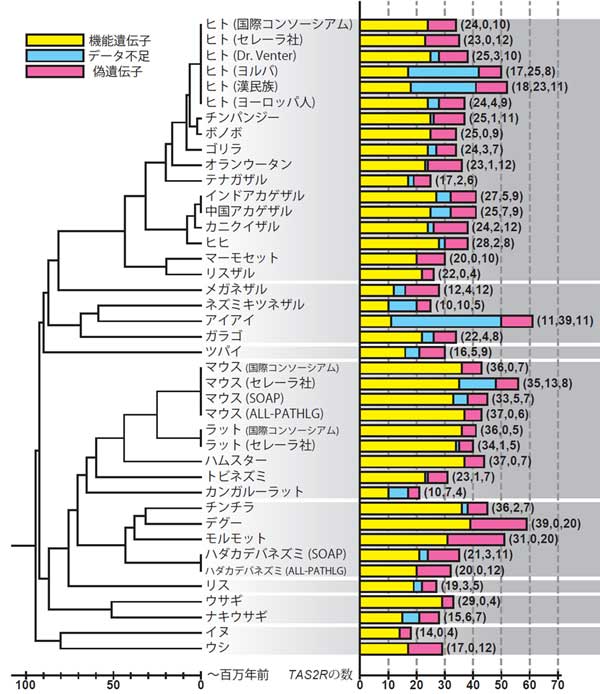Frequent Expansions of the Bitter Taste Receptor Gene Repertoire during Evolution of Mammals in the Euarchontoglires Clade早川卓志, 鈴木-橋戸南美, 松井淳, 郷康広 マカクやマウスのようなモデル生物の研究に代表されるように、真主齧上目(サル目、ヒヨケザル目、ツパイ目、ネズミ目、ウサギ目から構成される系統)の哺乳類におけるゲノム研究は、ヒトの生物学的特徴を理解する上で重要である。また、真主齧類は様々な生態環境に適応放散を果たしているので、これらのゲノムには過去のダイナミックな進化の痕跡が刻まれていることも興味深い。本研究では、39種類の全ゲノムアセンブリデータを対象に類似性検索を行い、28種の真主齧類動物における苦味受容体遺伝子(TAS2R)の進化過程を調査した。それぞれの真主齧類が有する機能的なTAS2R遺伝子の個数は、最小の種で16個、最大の種で40個と変化に富んでおり、共通祖先における機能的なTAS2R遺伝子の個数は少なくとも26個であると推定された。対象とした真主齧類の全TAS2Rの遺伝子系統樹を構築したところ、真主齧類のいくつかの分類群で、少なくとも7回の系統特異的な顕著な遺伝子重複イベントが生じていた。こうした遺伝子重複はとりわけ真猿類(ヒト、類人猿、旧世界ザル、新世界ザルから構成される系統)の祖先において特徴的で、嗅覚などの他の感覚とのトレードオフや、植物食性の発達などの、真猿類に見られる形質と関係する適応進化が示唆された。更に、これらの真猿類で拡大したTAS2Rレパートリー(真猿類クラスター)の一部は、ヒト上科のそれぞれの種で独立に、異所的な相同組換えによって全遺伝子欠失が起きており、現在進行形の進化が示唆された。本研究における発見は、多様な生態環境に対する感覚適応進化の機能に関する知見を提供するとともに、ヒトを含む真主齧類の味覚多様性の背景にある分子メカニズムを理解する重要な手がかりを与えるものである。
DOI: http://dx.doi.org/10.1093/molbev/msu144
Molecular Biology and Evolution 2014; doi: 10.1093/molbev/msu144
First published online: April 23, 2014

Genome studies of mammals in the superorder Euarchontoglires (a clade that comprises the orders Primates, Dermoptera, Scandentia, Rodentia, and Lagomorpha) are important for understanding the biological features of humans, particularly studies of medical model animals such as macaques and mice. Furthermore, the dynamic ecoevolutionary signatures of Euarchontoglires genomes may be discovered because many species in this clade are characterized by their successful adaptive radiation to various ecological niches. In this study, we investigated the evolutionary trajectory of bitter taste receptor genes
(TAS2Rs) in 28 Euarchontoglires species based on homology searches of 39 whole-genome assemblies. The Euarchontoglires species possessed variable numbers of intact
TAS2Rs, which ranged from 16 to 40, and their last common ancestor had at least 26 intact
TAS2Rs. The gene tree showed that there have been at least seven lineage-specific events involving massive gene duplications. Gene duplications were particularly evident in the ancestral branches of anthropoids (the anthropoid cluster), which may have promoted the adaptive evolution of anthropoid characteristics, such as a trade-off between olfaction and other senses and the development of herbivorous characteristics. Subsequent whole-gene deletions of anthropoid cluster
TAS2Rs in hominoid species suggest ongoing ectopic homologous recombination in the anthropoid cluster. These findings provide insights into the roles of adaptive sensory evolution in various ecological niches and important clues related to the molecular mechanisms that underlie taste diversity in Euarchontoglires mammalian species, including humans. MAY/27/2014
Copyright(C) 2014 PRI ( ). ).
|







